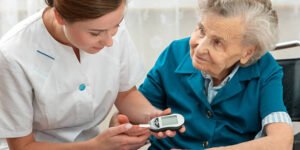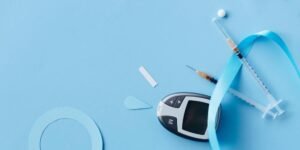
Type 2 Diabetes – Diagnosis and Treatment, Differences Between Type 1 and Type 2
Type 2 diabetes may cause symptoms such as frequent urination, thirst, easy hunger, weight loss, fatigue, blurred vision, difficulty in wound healing, etc. However, the symptoms may not be obvious and may be ignored. Patients with type 2 diabetes only learn that they have diabetes through blood glucose testing during health check-ups. The following will take you to further understand the diagnosis and treatment of type 2 diabetes, and briefly explain the difference between type 1 diabetes and type 2 diabetes. (Added video on the same scene: Understanding the symptoms and treatment of diabetes)
Diagnosis of type 2 diabetes
Diagnosing type 2 diabetes includes the following four testing methods:
- Fasting blood glucose
Fasting plasma glucose (FPG) is tested by fasting for at least 8 hours. If the detected blood sugar value is equal to or greater than 126 mg/dl, it may be type 2 diabetes. - Oral glucose tolerance test
The oral glucose tolerance test (OGTT) method is to take a solution containing 75g of glucose orally for 2 hours. If the blood sugar value measured is equal to or greater than 200 mg/dl, it may be type 2 diabetes. - Glycated hemoglobin
Detecting glycated hemoglobin (also known as glycated hemoglobin, Hemoglobin A1C, referred to as HbA1c, A1C) can detect the average blood sugar value in the past 2 to 3 months. When it is equal to or greater than 6.5%, you may have diabetes. As for this detection method, it is recommended that a second test at another time will be more accurate. - Random blood sugar
Measurements can be taken at any time of the day, including after eating. When the measured blood sugar value is equal to or greater than 200mg/dl, and is accompanied by symptoms of diabetes, such as frequent urination, frequent thirst, weight loss, etc., it may be type 2 diabetes.
The American Diabetes Association (ADA) recommends getting into the habit of regularly checking for type 2 diabetes starting at age 45, especially if you are overweight. If the result is normal, it is recommended to do a test every 3 years. If the test result is close to the upper limit of the standard, it is recommended to consult the doctor when the next examination time will be.
Type 2 diabetes treatment
Type 2 diabetes cannot be completely cured. The best situation is to maintain a healthy diet and lifestyle without excessive drug control. It is recommended that for patients with type 2 diabetes, the best way to improve type 2 diabetes is to focus on lifestyle habits and work and rest, as follows:
- lose weight
- healthy diet
- exercise regularly
- Proper use of diabetes medications or insulin therapy
- blood glucose monitoring
- lose weight
Losing weight can lower blood sugar. Even if you only lose 5 to 10% of your body weight, it will have a slight effect. The ideal thing is to lose weight continuously and reduce your body weight by at least 7% to have a more obvious impact on blood sugar. Portion control and eating healthy foods are simple ways to start losing weight.
healthy diet
Although there is no exclusive or fixed diet for diabetics, the following principles must be followed:
- Reduce caloric intake
- Reduce refined carbohydrates (especially sweets)
- Reduce your intake of saturated fat
- Eat more vegetables and fruits
- Eat more fiber-containing foods

Exercise more
Everyone needs regular exercise, especially those with type 2 diabetes. You can choose activities that you enjoy, such as walking, swimming and cycling, and ideally make these part of your daily routine to help stabilize your blood sugar. Each exercise should last for 30 to 60 minutes of moderate exercise, and 15 to 30 minutes for vigorous exercise. It is recommended that before engaging in any exercise, you consult your doctor to see if the intensity and difficulty are suitable for you.
If the above are well controlled, they can not only help stabilize blood sugar, but also delay the occurrence of complications.

Differences and diagnosis between type 1 and type 2
The obvious difference between type 1 diabetes and type 2 diabetes lies in the age of onset, because the main cause of type 1 diabetes is congenital lack of insulin, while type 2 diabetes is also affected by genetic factors, but mostly by acquired environmental factors. Type 1 diabetes usually occurs in children and adolescents, while type 2 diabetes is more common in adults.
Other differences: duration of onset, body size, presence of antibodies
Type 1 diabetes is caused by the pancreas being attacked by its own immune system, so the onset is short and sudden, and symptoms are easy to detect and diagnose at an early stage. In contrast, type 2 diabetes will first go through the “pre-diabetes” stage. ” stage, the initial symptoms are not obvious, and you usually have to test your blood sugar or wait until complications occur to discover that you are diabetic. In terms of symptoms, common diabetes symptoms are caused by high blood sugar, so there is actually no significant difference between the two.
If you are diagnosed with diabetes, your doctor may order other tests to differentiate between type 1 and type 2 diabetes. From blood tests, patients with type 1 diabetes usually have an autoantibody called glutamic acid decarboxylase autoantibody (GAD-Ab). Patients with type 2 diabetes are generally fatter than those with type 1 diabetes and do not have this antibody in their bodies.
In addition to the tests listed above, doctors will measure blood pressure and take regular blood and urine samples to test cholesterol levels, thyroid function, liver function, kidney function, and more.












